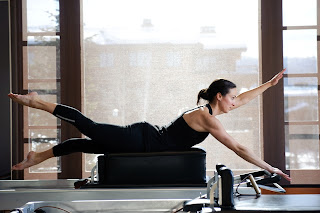Pilates is more than a popular fitness trend with a
hard-to-pronounce name (puh-LAH-tees). It will strengthen your core and leave
you feeling centered from the inside out.
What is Pilates?
Pilates is a unique system of exercises designed to
strengthen and lengthen the muscles. The series consists of floor exercises (called
matwork) and exercises on specialized Pilates equipment. The rhythmic movements
of the Pilates method promote elongated and toned muscles of the core or
"powerhouse", which include the deep abdominals and low back muscles,
as well as muscles of the shoulder and pelvic girdles.
Pilates requires students to work “from the inside out”,
using the deep muscles of the body’s core to initiate movement and stabilize
the body.
The Pilates method evolved after Joseph Pilates, a nurse in
World War I, developed a conditioning program he called “contrology.” The
method consisted of 34 movements performed on the floor and designed to
strengthen the body’s core. (These movements are now referred to as the Pilates
matwork.) Later, he supplemented this work by rigging up the springs on
hospital beds and assisting patients with rehabilitation. These spring-based
exercises led to the development of his specialized Pilates equipment, which
would supplement his original matwork.
Joseph Pilates regarded his method as a way of life and a
path to total health rather than merely a series of exercises. He believed that
the whole body must be exercised to achieve good health.
Principles of Pilates
Pilates is based on six principles: breath, concentration,
control, centering, precision, and flow. While students learn to move from the
body’s core, they also learn to quiet the mind and tune in to the specific
needs of the body.
Pilates conditions the body as a whole, training several
muscles at once so that no muscle group is over or under-trained. In Pilates,
the emphasis is on proper breathing, correct body alignment, and purposeful
movement patterns; the result is an increased awareness of how your body moves
and feels in space.
Many students of Pilates report that they feel calmer and
stand taller as a result of the practice.
READY TO TRY PILATES?
Sign up for one of our Wall Unit clinics:
Julie:
May 3-31, 4 sessions, one per week
Fridays, 9:00-10:00am
Emily:
May 1-30, 4 sessions, one per week
Mondays 9:00-10:00am or 10:00-11:00am (advanced)
Tuesdays, 12:00-1:00pm
Wednesdays, 9:00-10:00am
Thursdays, 10:00-11:00am (advanced)
Members $100 / Non-members $120
Core strengthening and stretching!
Sign up in advance to reserve your spots today.






